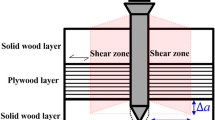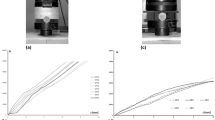Abstract
Since the 80’s, Johanssen’s Yield Theory has been adapted to fit new design practices: fastening of timber elements with a layer of insulation (or gap) between the elements or fastening with inclined fasteners. However no rules exist for connections with large gaps (up to 500 mm) and inclined fasteners. The behaviour of screwed connections (timber/large gap/timber) is modelled using an orthotropic material, cohesive surface, Hill criterion and a fictitious material that wraps the screw and models a complex medium where steel and wood interact. The calibrated FE model is finally compared to experimental results.




Similar content being viewed by others
References
Descamps T, Lalisse D, Datoussaïd S (2009) 3D FEM modeling of slender laterally loaded timber fasteners. In: Curran Associates (ed) Proceedings of the 12th international conference on fracture, July 12–17, Ottawa, Canada
Dietsch P, Brandner R (2015) Self-tapping screws and threaded rods as reinforcement for structural timber elements—A state-of-the-art report. Constr Build Mater 97:78–89. doi:10.1016/j.conbuildmat.2015.04.028 (special issue: Reinforcement of Timber Structures)
Gabriela T, Erik S, René S (2011) State-of-the-art review on timber connections with glued-in steel rods. Mater Struct 44(5):997–1020
Gonzales E, Tannert T, Avez C (2015) Timber joints with multiple glued-in steel rods. In: Proceedings of the third international conference on adhesive bonding, Porto
Jockwer R (2014) Structural behaviour of glued laminated timber beams with unreinforced and reninforced notches. PhD thesis, ETH Zurich
Jockwer R, Steiger R, Frangi A (2014) Fully threaded self-tapping screws subjected to combined axial and lateral loading with different load to grain angles. In: Aicher S, Reinhardt HW, Garrecht H (eds) Materials and joints in timber structures, vol 9. Springer, The Netherlands, pp 265–272
Lathuilliére D, Bléron L, Descamps T, Bocquet JF (2015) Reinforcement of dowel type connections. Constr Build Mater 97:48–54. doi:10.1016/j.conbuildmat.2015.05.088 (special issue: Reinforcement of Timber Structures)
Statens Byggeforskningsinstitut - Danish Building Research (1994) Trækonstruktioner: Beregning. SBIanvisning - Danish Standard (in Danish)
Tomasi R, Crosatti A, Piazza M (2010) Theoretical and experimental analysis of timber-to-timber joints connected with inclined screws. Constr Build Mater 24(9):1560–1571
Acknowledgments
The authors would like to thank COST FP1404 for the support of Mr. Laurent Loskool’s stay at Lund University, Sweden, through a “Short Term Scientific Mission” grant, which made this research possible. We would like to extend the warmest thanks to iTechwood, KHL and Rothoblaas companies for their support.
Author information
Authors and Affiliations
Corresponding author
Rights and permissions
About this article
Cite this article
Avez, C., Descamps, T., Serrano, E. et al. Finite element modelling of inclined screwed timber to timber connections with a large gap between the elements. Eur. J. Wood Prod. 74, 467–471 (2016). https://doi.org/10.1007/s00107-015-1002-1
Received:
Published:
Issue Date:
DOI: https://doi.org/10.1007/s00107-015-1002-1




